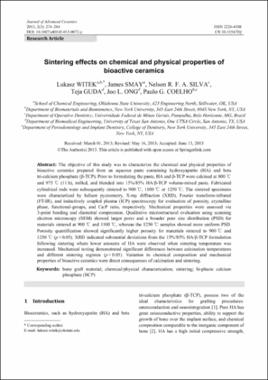| dc.contributor.author | Witek, Lukasz | |
| dc.contributor.author | Smay, James | |
| dc.contributor.author | Silva, Nelson R. F. A. | |
| dc.contributor.author | Guda, Teja | |
| dc.contributor.author | Ong, Joo L. | |
| dc.contributor.author | Coelho, Paulo G. | |
| dc.date.accessioned | 2019-09-25T18:24:44Z | |
| dc.date.available | 2019-09-25T18:24:44Z | |
| dc.date.issued | 2013 | |
| dc.identifier | oksd_witek_sinteringeffect_2013-09-01 | |
| dc.identifier.citation | Witek, L., Smay, J., Silva, N. R. F. A., Guda, T., Ong, J. L., & Coelho, P. G. (2013). Sintering effects on chemical and physical properties of bioactive ceramics. Journal of Advanced Ceramics, 2(3), 274-284. https://doi.org/10.1007/s40145-013-0072-y | |
| dc.identifier.uri | https://hdl.handle.net/11244/321443 | |
| dc.description.abstract | The objective of this study was to characterize the chemical and physical properties of bioactive ceramics prepared from an aqueous paste containing hydroxyapatite (HA) and beta tri-calcium phosphate (β-TCP). Prior to formulating the paste, HA and β-TCP were calcined at 800 °C and 975 °C (11 h), milled, and blended into 15%/85% HA/β-TCP volume-mixed paste. Fabricated cylindrical rods were subsequently sintered to 900 °C, 1100 °C or 1250 °C. The sintered specimens were characterized by helium pycnometry, X-ray diffraction (XRD), Fourier transform-infrared (FT-IR), and inductively coupled plasma (ICP) spectroscopy for evaluation of porosity, crystalline phase, functional-groups, and Ca:P ratio, respectively. Mechanical properties were assessed via 3-point bending and diametral compression. Qualitative microstructural evaluation using scanning electron microscopy (SEM) showed larger pores and a broader pore size distribution (PSD) for materials sintered at 900 °C and 1100 °C, whereas the 1250 °C samples showed more uniform PSD. Porosity quantification showed significantly higher porosity for materials sintered to 900 °C and 1250 °C (p< 0.05). XRD indicated substantial deviations from the 15%/85% HA/β-TCP formulation following sintering where lower amounts of HA were observed when sintering temperature was increased. Mechanical testing demonstrated significant differences between calcination temperatures and different sintering regimes (p < 0.05). Variation in chemical composition and mechanical properties of bioactive ceramics were direct consequences of calcination and sintering. | |
| dc.format | application/pdf | |
| dc.language | en_US | |
| dc.publisher | SpringerOpen | |
| dc.rights | This material has been previously published. In the Oklahoma State University Library's institutional repository this version is made available through the open access principles and the terms of agreement/consent between the author(s) and the publisher. The permission policy on the use, reproduction or distribution of the material falls under fair use for educational, scholarship, and research purposes. Contact Digital Resources and Discovery Services at lib-dls@okstate.edu or 405-744-9161 for further information. | |
| dc.title | Sintering effects on chemical and physical properties of bioactive ceramics | |
| osu.filename | oksd_witek_sinteringeffect_2013-09-01.pdf | |
| dc.description.peerreview | Peer reviewed | |
| dc.identifier.doi | 10.1007/s40145-013-0072-y | |
| dc.description.department | Chemical Engineering | |
| dc.type.genre | Article | |
| dc.type.material | Text | |
| dc.subject.keywords | bone graft material | |
| dc.subject.keywords | chemical/physical characterization | |
| dc.subject.keywords | sintering | |
| dc.subject.keywords | bi-phasic calcium phosphate (bcp) | |
